Introduction
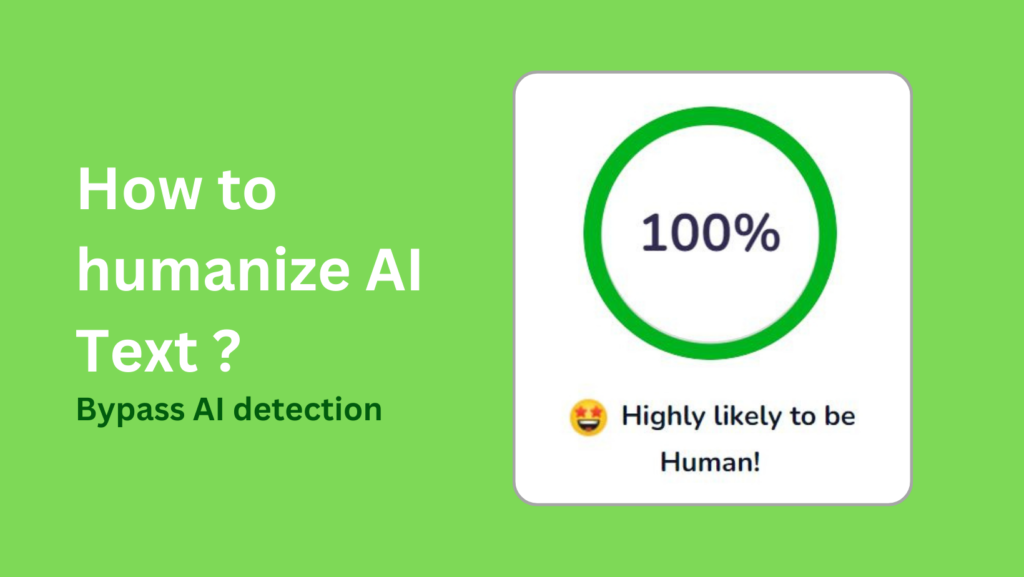
AI has totally changed the game when it comes to creating written stuff.
Tools like ChatGPT and others have made it super easy to generate text for all sorts of things.
But here’s the thing – sometimes, AI-generated content feels a bit, well, robotic, like it lacks that human touch.
It’s functional, but it doesn’t quite have the personality and warmth of content crafted by a real person as ChatGPT uses so much buzz words.
And that’s not even the worst of it. There’s the whole SEO side of things to consider too.
Sure, AI-generated content can help you rank on Google, but only if it meets Google’s strict criteria for Expertise, Authoritativeness, and Trustworthiness (E-A-T).
But, don’t worry. In this article, we’re going to tackle all those concerns about how to humanize AI generated text.
We’ve got some surefire strategies to humanize AI text and make it feel more human, and they’ll not only keep it from getting flagged as machine-generated but also make it a whole lot better.
So, here’s the game plan: first, we’ll dive into the art of crafting prompts (prompt engineering) that coax AI into sounding more like you.
Then, I’ll introduce you to a tool that adds those human-like qualities seamlessly.
Get ready to uncover the ways that will turn your AI-generated text into content that not only climbs the rankings but also grabs your readers’ attention and keeps them engaged.
Method 1: Humanizing AI Text by mastering prompt Engineering
What is Prompt Engineering?
“Prompt engineering is the art of sculpting ideas into reality, where creativity meets robots, and innovation knows no bounds.”
Roboreachai
So, prompt engineering is like giving specific instructions or questions to interact with natural language processing (NLP) models like GPT-3.5 to get desired output.
The goal of prompt engineering is to formulate prompts that guide the NLP model in producing relevant, accurate, and contextually appropriate responses.
It involves carefully choosing the wording, structure, and context of the input to achieve specific tasks or generate desired outputs.
In simple terms prompt engineering means telling a computer program what you want it to do by asking it questions or giving it specific instructions.
It’s like talking to a robot and making sure you ask the right questions so it gives you the right answers.
For example: Suppose you’re using ChatGPT, and you want to get a recipe for chocolate chip cookies.
So, you directly just ask ChatGPT “Could you please share a recipe for chocolate chip cookies?“
But to do prompt engineering correctly, you should ask it in a way that’s clear, like “Hello, I love eating dark chocolate chip cookies. But I only eat gluten-free cookies. Today I’m in the mood for some homemade chocolate chip cookies with a classic sweetness level. Give me the recipe to make a larger batch. The cookies should be soft and chewy. Nuts and dried fruits are must ingredients.“
This way, ChatGPT will understand what you’re looking for, and it can give you a delicious cookie recipe.
Why is the prompt engineering important?
Well, if we don’t do it right, the computer AI tool you’re using get confused or give us the wrong info.
So, prompt engineering is about talking to these smart programs in a way they understand and give us the right stuff we’re looking for.
In short prompt engineering is our trusty AI text humanizer.
Using prompt engineering to humanize AI Text
Prompt works on all kind of tools. No matter if you’re using ChatGPT or any other bot. When you nail prompt engineering the output generated by AI tools becomes original, natural and trustworthy. So, let’s have a chat with ChatGPT by crafting a perfect prompt and see how does the output look like.
Consider a simple Use Case: You have a product (online course) ready to launch and you need to run its marketing campaign via Facebook ads. So, you need a compelling ad copy to get maximum ROI.
Step 1. Assigning it a Role
Okay, first things first, you need to pick a character or role for ChatGPT to act as. Think of it like giving the AI a job or a personality. It could be a marketer, doctor, engineer, or whatever you like. This role will shape how ChatGPT talks and acts in the text it generates. For example, if you assign the role of a marketer, ChatGPT will generate text with a marketing perspective, using marketing language and tactics.
Prompt for our use case: Act as a senior digital marketer who specializes in infotainment courses and Facebook ads. Over the years, you have had the privilege of helping numerous individuals and organizations successfully sell their courses through effective ad campaigns. One of the key reasons behind your conversion rates is your strategic approach to crafting ad copy.
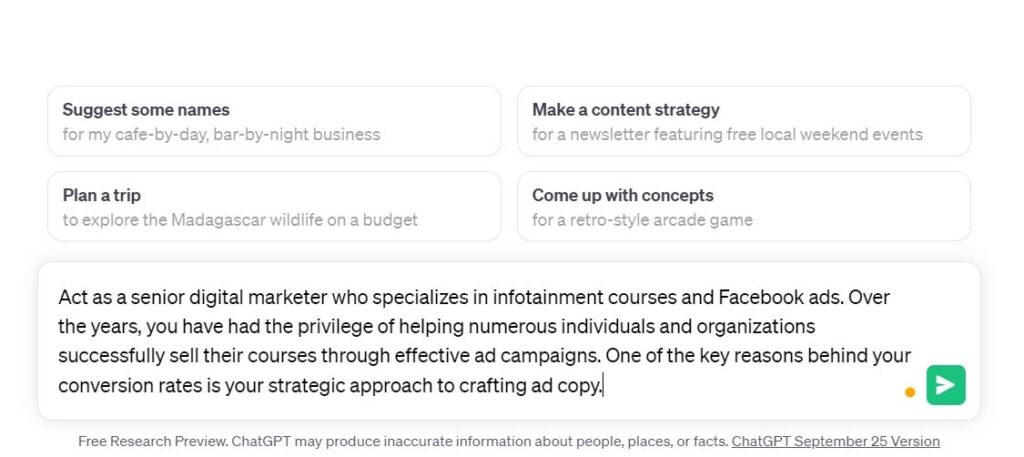
Step 2. Assigning it the Task
Once you’ve got the role in mind, tell ChatGPT what you want it to do. Give it a task. Maybe you want it to write marketing content, create an ad, draft a tech report, or something else entirely. Be clear about the job you’re assigning, so ChatGPT knows what’s expected and can give you the right kind of text.
Prompt for our use case: I’m reaching out to my subscribers, most of these subscribers are between the age of 18-25. Their goal is to make money through YouTube videos. You need to create an ad campaign where I can reach out to them via Facebook ads and sell my course. My course contains video lectures that cover every aspect of building a successful YouTube business (from creating engaging videos to monetizing the channel). Start with a clear hook. Mention some of the problems that YouTubers might face and why my course is the solution.
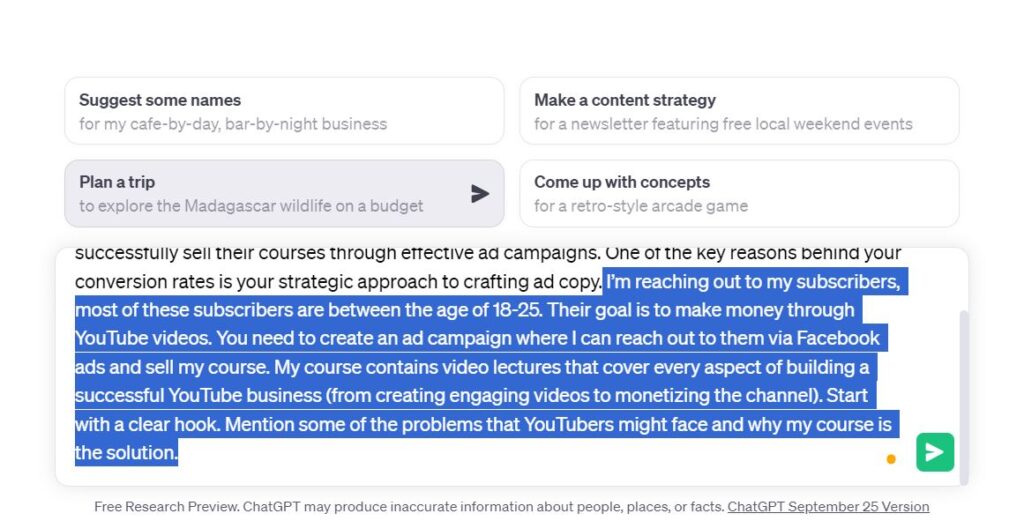
Step 3. Adding Constraints (Negative prompts)
Now, think about the things you don’t want in the text. Tell ChatGPT about the stuff you want it to avoid. This could be avoiding specific words, staying away from jargon, or not making certain claims. These rules help ChatGPT stay on track and make sure the text sounds natural and doesn’t go off-topic.
Prompt for our use case: Keep the limit to 40 characters for the Title, 300 characters for the primary text, and 50 characters for the description. Avoid using buzzwords and words that feel promotional.
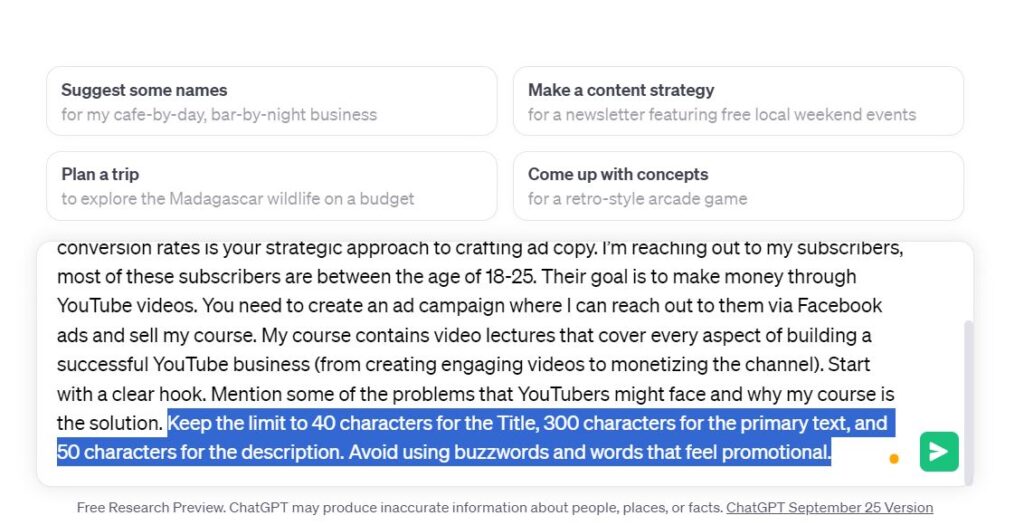
Step 4. Setting Expectations
Lastly, let ChatGPT know the mood you want. Do you want the text to sound friendly, professional, or just like a casual chat? By setting this vibe, you make sure the AI-generated text feels more like it’s coming from a real person in the chosen role and task.
Prompt for our use case: Keep your tone natural, original, and conversational like you’re talking with someone over the coffee table.

The Output
Title: Unlock YouTube Success 🎥
Primary Text: Hey there, YouTube enthusiast! 🚀
Struggling with video ideas? 🤔
Monetization a mystery? 💰
Discover the ultimate YouTube playbook in my course! 📚
Unlock creativity, captivate your audience, and cash in on your passion. 🤑
Join me today and turn your channel into a money-making machine! 💸
Description: Learn the art of YouTube success. 🎬 Get started now! 🚀
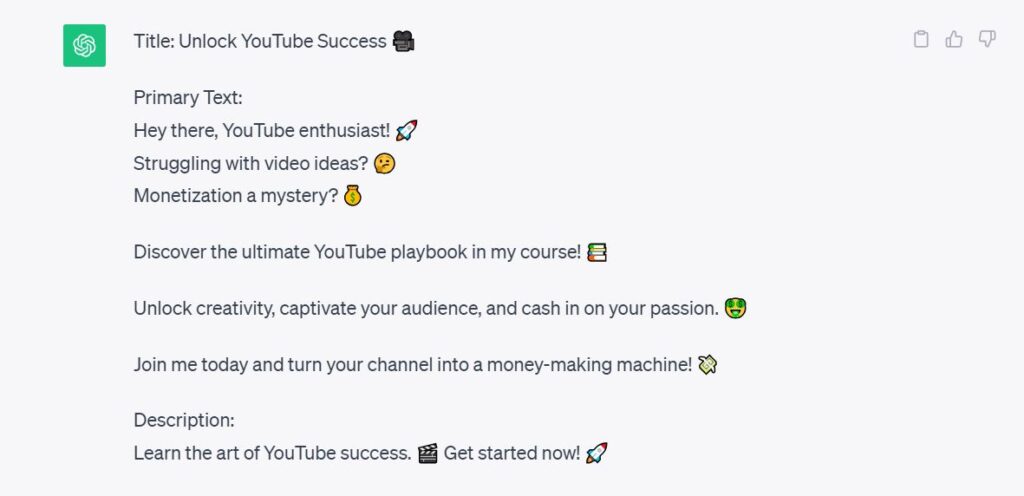
As you can see this output is optimized for maximum ROI for our Facebook ad campaign because it addresses the target audience’s pain points, maintains a concise and engaging format, and feels entirely human-written.
By using prompt engineering, we provided clear instructions to the AI, resulting in natural and relatable ad copy that resonates with the audience, increasing the likelihood of conversion.
Things to remember:
Prompt engineering is an ongoing process and needs consistent efforts and experiments to have a full grip on it. You’ll have to try different prompts with different words, structure and context. But once you nail it – it’s worth it.
Method 2: 5 best Undetectable AI tools to bypass AI detection.
Using undetectable AI tool can surely help to bypass any AI detection tool.
These tools do this is by mimicking the patterns and nuances of human writing so closely that it’s tough for those AI detectors to spot any differences.
They analyze things like sentence structure, word choice, and even the way paragraphs are organized.
Some of these tools also throw in some randomness to make the text less predictable, making it even trickier for detection.
Overall, it’s a bit of a cat-and-mouse game where these AI tools keep evolving to outsmart the detection systems, while the detection systems work hard to catch on to the tricks.
1. AI Text Humanizer by Rephraser.co

Rephraser.co AI humanizer tool turns AI-generated content into a more human-like version that sounds like a human wrote it. It uses Machine Learning (ML) technology & Natural Language Processing (NLP) techniques to analyze the text & break it down into smaller, more digestible parts. The tool then reorganizes the structure of the text, eliminates all unnecessary phrases, & replaces words with simpler synonyms. Moreover, this text humanizer adds transitional words & phrases to the text to make it look more natural & human-sounding.
The end results? You’ll get a humanized version of the text that bypasses AI detector tools. The good thing about this tool is that it doesn’t change the intended meaning of the text. Instead, it strictly retains the intent. It’s easy to use. All you need to do is open the tool, paste your content into the given box, & click the “Humanize Text” button. It will transform your text in a few seconds.
In addition, this humanizer online tool offers a special mode called Super Mode. You can purchase its premium version to reap the full advantages of this mode. It makes sure the text flows naturally. Simply put, Rephraser.co’s humanize AI tool is a great resource for humanizing AI text.
2. UndetectableContent AI
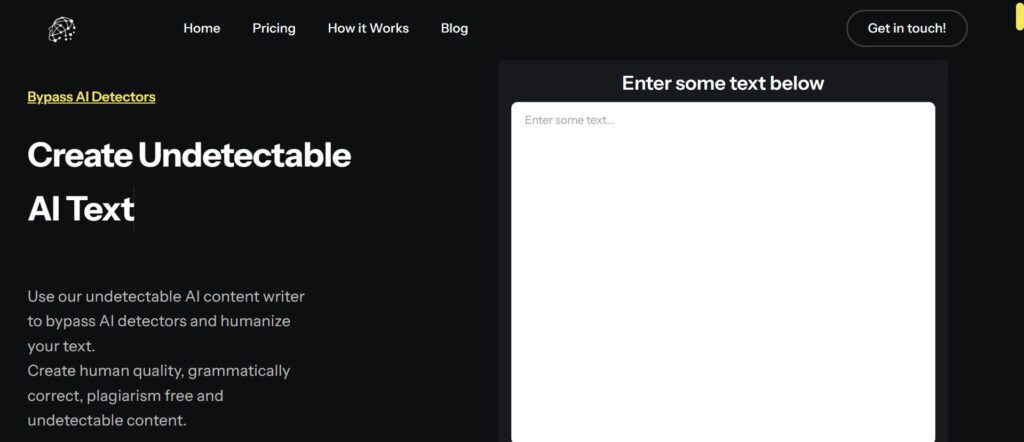
Ever thought about having a super sneaky pen for your online writing adventures? Well, meet Undetectablecontent AI – it’s like a secret weapon in the world of digital writing! This cool tool isn’t just an ordinary text helper; it’s like a smart writer buddy that makes sure your AI-made content smoothly moves through the online world without getting noticed.
Just imagine having a buddy that not only dodges those AI detectors but also creates content that feels just like a person wrote it. And guess what? It won’t cost you a dime, making it available for everyone who loves spinning digital tales. So, if you’re up for a digital disguise in your writing journey, Undetectablecontent AI is your pass to a super cool writing experience like never before!
3. ArticleForge

ArticleForge is the first fully automatic AI articles writer. Article Forge is a pro at making long, search-engine-friendly articles in just one click. This tool is a game-changer for content creators, writers, bloggers, and businesses seeking to produce top-notch, unique content without the time-consuming and expensive process of manual content creation. It learns from all the information it reads and figures out how to put words together in a way that makes sense. Article Forge not only saves time and resources but also ensures that the generated content is SEO-friendly, aligning perfectly with Google’s quality and relevancy standards.
4. AI Humanizer
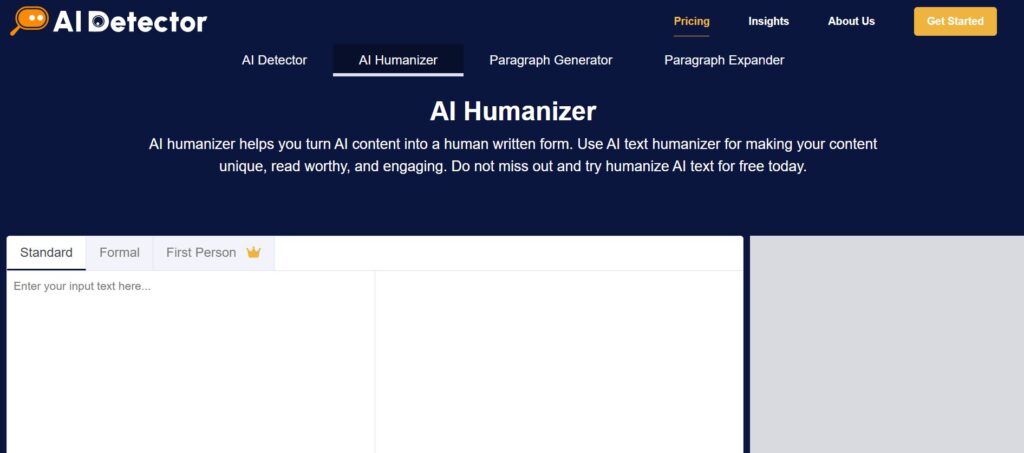
AI humanizer is available inline without any subscription and signup process. It is best in humanizing your AI generated text with a single click. Is there any time in your life when you think about not getting caught for cheating? Ever wished your AI-written text sounded more natural?
Here at ai-detector.info, the AI humanizer is a prime solution for making AI content feel like a real person wrote it. It’s like having a magic touch that transforms robotic text into natural writing.
With this free AI humanizing tool, your content won’t just pass AI detectors, it will engage readers with a human-like readability. The best part? It’s easy to use and perfect for anyone looking to refine their AI-generated text. It provides various modes for adding a unique text element like formal and first person mode for more connectivity.
Ready to make your content sound like a human writer does that?
5. Content at Scale
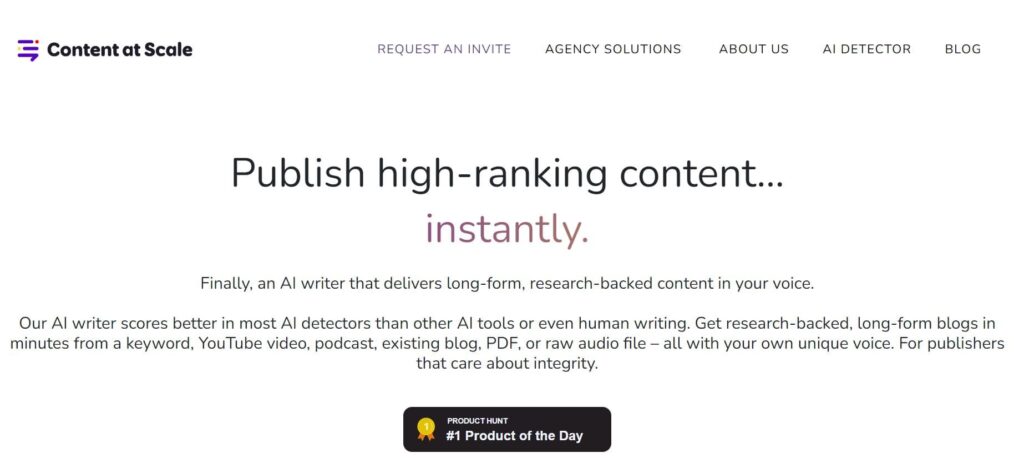
Content at Scale is an ingenious AI-powered content creation platform tailored for businesses and publishers aiming to simplify their content marketing endeavors and expand their online footprint.
What sets this platform apart is its remarkable knack for creating content that not only matches the quality of human writing but actually outperforms most AI detectors. In simpler terms, it makes content that’s so close to human-created material that you can hardly tell the difference.
This tool provides a wide range of content creation possibilities. You can use it to turn keywords, YouTube videos, podcasts, existing blogs, PDFs, or raw audio files into well-organized, SEO-friendly articles. It’s like a solution to the usual hurdles faced in content marketing – from finding and hiring writers to giving clear content directions, avoiding AI content detection issues, and managing the often hefty expenses of content creation.

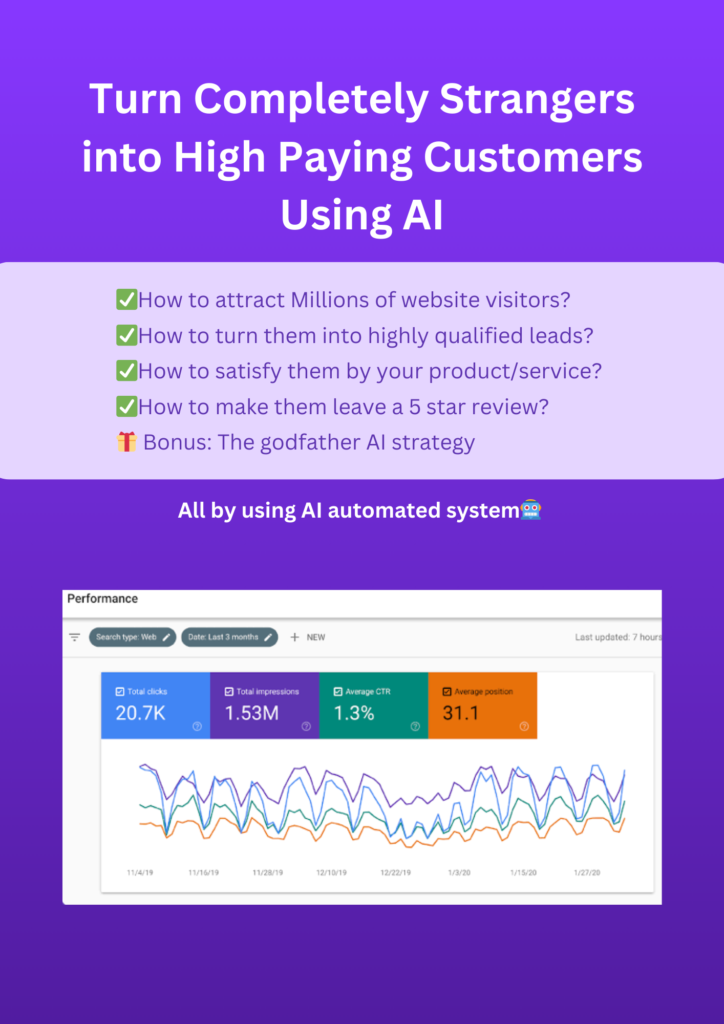
3 thoughts on ““How To Humanize AI Text? 5 Free Undetectable AI Tools””
I learned a lot from your article. Your ability to explain difficult concepts is impressive.
Nice Post
Even while AI has completely changed the content creation process, it still lacks a human touch that is obvious. This is when experts in education assignment help come in. They offer individualized advice, perspectives, and criticism catered to the need of each learner. Students can improve their comprehension, hone their writing abilities, and add a human touch to their work—something that AI-generated content frequently lacks—by using their knowledge.